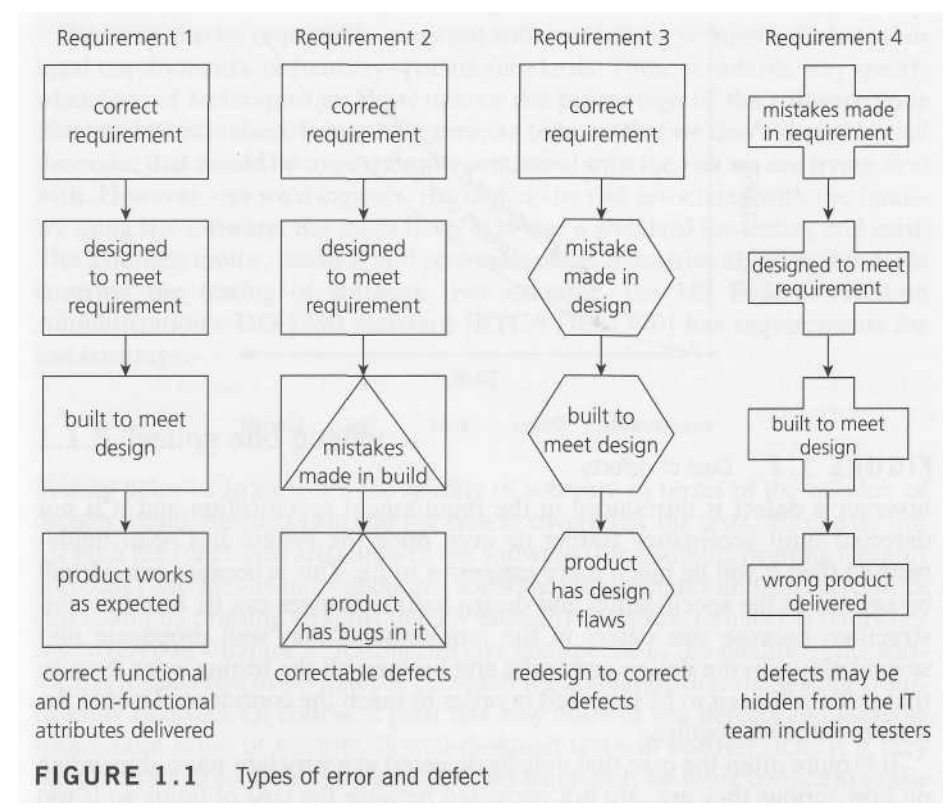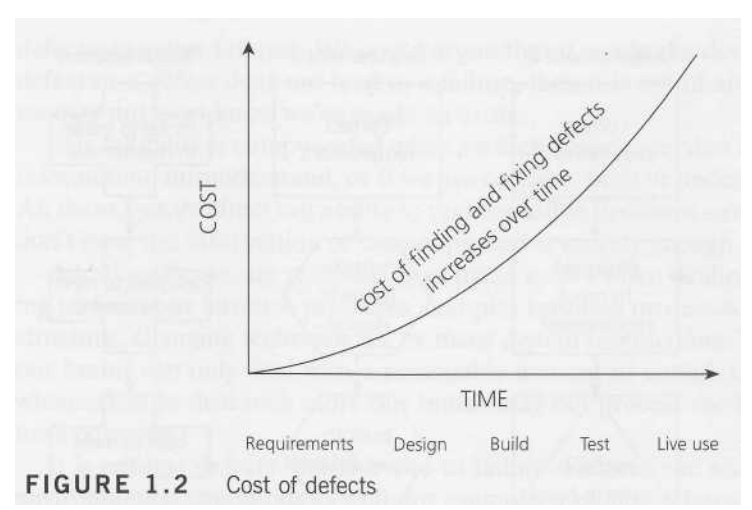1.1.3 Causes of software defects
Why is it that software systems sometimes don’t work correctly? We know that people make mistakes – we are fallible.
If someone makes an error or mistake in using the software, this may lead directly to a problem – the software is used incorrectly and so does not behave as we expected. However, people also design and build the software and they can make mistakes during the design and build. These mistakes mean that there are flaws in the software itself. These are called defects or sometimes bugs or faults. Remember, the software is not just the code; check the definition of software again to remind yourself.
When the software code has been built, it is executed and then any defects may cause the system to fail to do what it should do (or do something it shouldn’t), causing a failure. Not all defects result in failures; some stay dormant in the code and we may never notice them.
Do our mistakes matter?
Let’s think about the consequences of mistakes. We agree that any human being, programmers and testers included, can make an error. These errors may produce defects in the software code or system, or in a document. If a defect in code is executed, the system may experience a failure. So the mistakes we make matter partly because they have consequences for the products for which we are responsible.
Our mistakes are also important because software systems and projects are complicated. Many interim and final products are built during a project, and people will almost certainly make mistakes and errors in all the activities of the build. Some of these are found and removed by the authors of the work, but it is difficult for people to find their own mistakes while building a product.
Defects in software, systems or documents may result in failures, but not all defects do cause failures. We could argue that if a mistake does not lead to a defect or a defect does not lead to a failure, then it is not of any importance – we may not even know we’ve made an error.
Our fallibility is compounded when we lack experience, don’t have the right information, misunderstand, or if we are careless, tired or under time pressure.
All these factors affect our ability to make sensible decisions – our brains either don’t have the information or cannot process it quickly enough.
Additionally, we are more likely to make errors when dealing with perplexing technical or business problems, complex business processes, code or infrastructure, changing technologies, or many system interactions. This is because our brains can only deal with a reasonable amount of complexity or change – when asked to deal with more our brains may not process the information we have correctly.
It is not just defects that give rise to failure. Failures can also be caused by environmental conditions as well: for example, a radiation burst, a strong magnetic field, electronic fields, or pollution could cause faults in hardware or firmware. Those faults might prevent or change the execution of software.
Failures may also arise because of human error in interacting with the software, perhaps a wrong input value being entered or an output being misinterpreted.
Finally, failures may also be caused by someone deliberately trying to cause a failure in a system – malicious damage.
When we think about what might go wrong, we have to consider defects and failures arising from:
- errors in the specification, design and implementation of the software and system;
- errors in use of the system;
- environmental conditions;
- intentional damage;
- potential consequences of earlier errors, intentional damage, defects and failures.
When do defects arise?
In Figure 1.1 we can see how defects may arise in four requirements for a product. We can see that requirement 1 is implemented correctly – we understood the customer’s requirement, designed correctly to meet that requirement, built correctly to meet the design, and so deliver that requirement with the right attributes: functionally, it does what it is supposed to do and it also has the right non-functional attributes, so it is fast enough, easy to understand and so on.
With the other requirements, errors have been made at different stages. Requirement 2 is fine until the software is coded, when we make some mistakes and introduce defects. Probably, these are easily spotted and corrected during testing, because we can see the product does not meet its design specification.
The defects introduced in requirement 3 are harder to deal with; we built exactly what we were told to but unfortunately the designer made some mistakes so there are defects in the design. Unless we check against the requirements definition, we will not spot those defects during testing. When we do notice them they will be hard to fix because design changes will be required.

The defects in requirement 4 were introduced during the definition of the requirements; the product has been designed and built to meet that flawed requirement definition. If we test the product meets its requirements and design, it will pass its tests but may be rejected by the user or customer. Defects reported by the customer in acceptance test or live use can be very costly.
Unfortunately, requirements and design defects are not rare; assessments of thousands of projects have shown that defects introduced during requirements and design make up close to half of the total number of defects [Jones].
What is the cost of defects?
As well as considering the impact of failures arising from defects we have not found, we need to consider the impact of when we find those defects. The cost of finding and fixing defects rises considerably across the life cycle; think of the old English proverb ‘a stitch in time saves nine’. This means that if you mend a tear in your sleeve now while it is small, it’s easy to mend, but if you leave it, it will get worse and need more stitches to mend it.
If we relate the scenarios mentioned previously to Figure 1.2, we see that, if an error is made and the consequent defect is detected in the requirements at the specification stage, then it is relatively cheap to find and fix. The observation of increasing defect-removal costs in software traces back to [Boehm].
You’ll find evidence for the economics of testing and other quality assurance activities in [Gilb], [Black 2001] or [Black 2004]. The specification can be corrected and re-issued. Similarly if an error is made and the consequent defect detected in the design at the design stage then the design can be corrected and re-issued with relatively little expense. The same applies for construction. If however a defect is introduced in the requirement specification and it is not detected until acceptance testing or even once the system has been implemented then it will be much more expensive to fix. This is because rework will be needed in the specification and design before changes can be made in construction; because one defect in the requirements may well propagate into several places in the design and code; and because all the testing work done-to that point will need to be repeated in order to reach the confidence level in the software that we require

It is quite often the case that defects detected at a very late stage, depending on how serious they are, are not corrected because the cost of doing so is too expensive. Also, if the software is delivered and meets an agreed specification, it sometimes still won’t be accepted if the specification was wrong. The project team may have delivered exactly what they were asked to deliver, but it is not what the users wanted. This can lead to users being unhappy with the system that is finally delivered. In some cases, where the defect is too serious, the system may have to be de-installed completely.
